coolant level SATURN VUE 2009 Owners Manual
[x] Cancel search | Manufacturer: SATURN, Model Year: 2009, Model line: VUE, Model: SATURN VUE 2009Pages: 386, PDF Size: 2.3 MB
Page 65 of 386
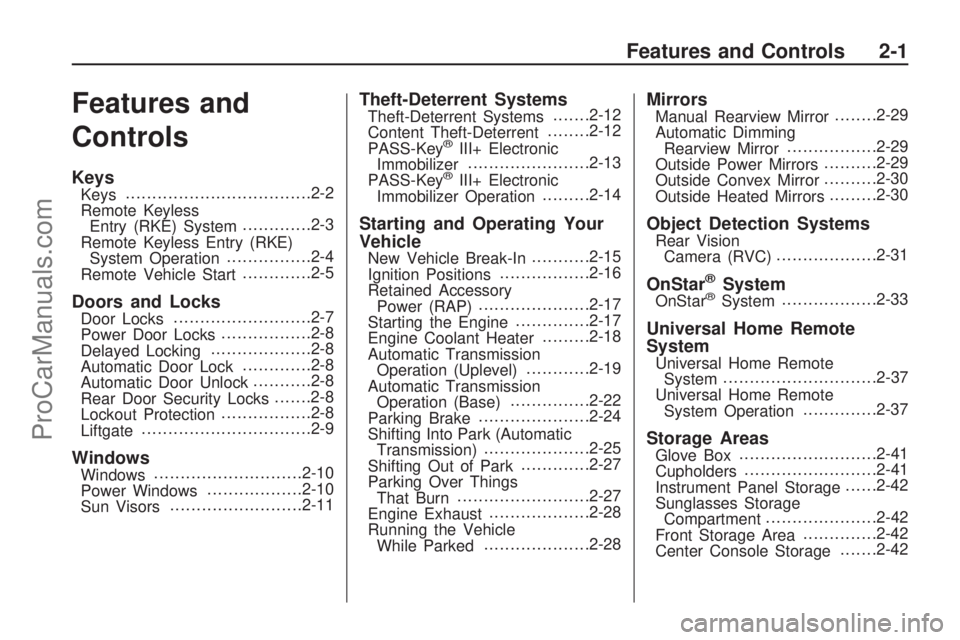
Features and
Controls
KeysKeys...................................2-2
Remote Keyless
Entry (RKE) System.............2-3
Remote Keyless Entry (RKE)
System Operation................2-4
Remote Vehicle Start.............2-5
Doors and LocksDoor Locks..........................2-7
Power Door Locks.................2-8
Delayed Locking...................2-8
Automatic Door Lock.............2-8
Automatic Door Unlock...........2-8
Rear Door Security Locks.......2-8
Lockout Protection.................2-8
Liftgate................................2-9
WindowsWindows............................2-10
Power Windows..................2-10
Sun Visors.........................2-11
Theft-Deterrent SystemsTheft-Deterrent Systems.......2-12
Content Theft-Deterrent........2-12
PASS-Key
®III+ Electronic
Immobilizer.......................2-13
PASS-Key
®III+ Electronic
Immobilizer Operation.........2-14
Starting and Operating Your
Vehicle
New Vehicle Break-In...........2-15
Ignition Positions.................2-16
Retained Accessory
Power (RAP).....................2-17
Starting the Engine..............2-17
Engine Coolant Heater.........2-18
Automatic Transmission
Operation (Uplevel)............2-19
Automatic Transmission
Operation (Base)...............2-22
Parking Brake.....................2-24
Shifting Into Park (Automatic
Transmission)....................2-25
Shifting Out of Park.............2-27
Parking Over Things
That Burn.........................2-27
Engine Exhaust...................2-28
Running the Vehicle
While Parked....................2-28
MirrorsManual Rearview Mirror........2-29
Automatic Dimming
Rearview Mirror.................2-29
Outside Power Mirrors..........2-29
Outside Convex Mirror..........2-30
Outside Heated Mirrors.........2-30
Object Detection SystemsRear Vision
Camera (RVC)...................2-31
OnStar®SystemOnStar®System..................2-33
Universal Home Remote
System
Universal Home Remote
System.............................2-37
Universal Home Remote
System Operation..............2-37
Storage AreasGlove Box..........................2-41
Cupholders.........................2-41
Instrument Panel Storage......2-42
Sunglasses Storage
Compartment.....................2-42
Front Storage Area..............2-42
Center Console Storage.......2-42
Features and Controls 2-1
ProCarManuals.com
Page 112 of 386
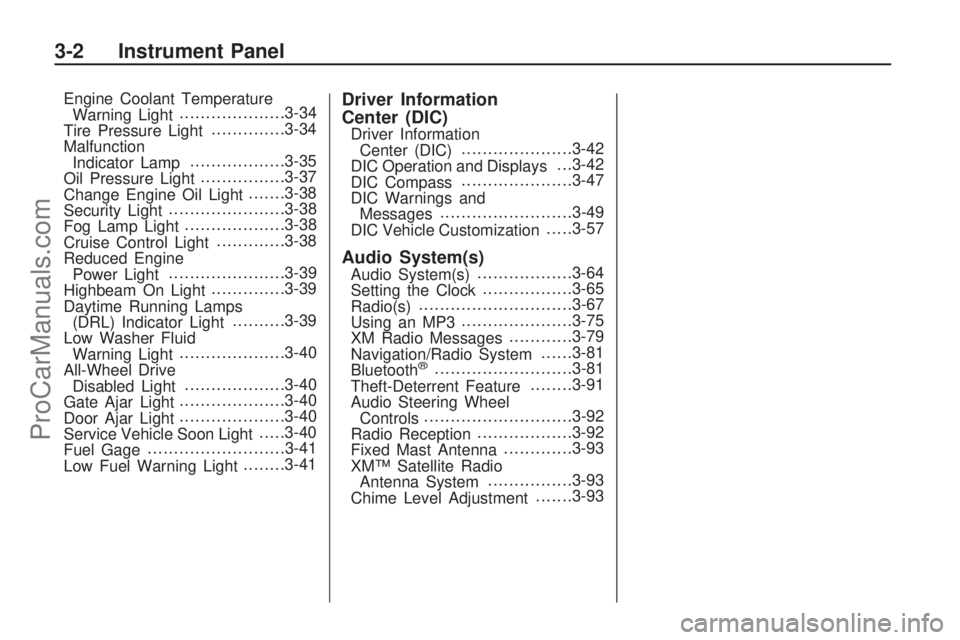
Engine Coolant Temperature
Warning Light....................3-34
Tire Pressure Light..............3-34
Malfunction
Indicator Lamp..................3-35
Oil Pressure Light................3-37
Change Engine Oil Light.......3-38
Security Light......................3-38
Fog Lamp Light...................3-38
Cruise Control Light.............3-38
Reduced Engine
Power Light......................3-39
Highbeam On Light..............3-39
Daytime Running Lamps
(DRL) Indicator Light..........3-39
Low Washer Fluid
Warning Light....................3-40
All-Wheel Drive
Disabled Light...................3-40
Gate Ajar Light....................3-40
Door Ajar Light....................3-40
Service Vehicle Soon Light.....3-40
Fuel Gage..........................3-41
Low Fuel Warning Light........3-41Driver Information
Center (DIC)
Driver Information
Center (DIC).....................3-42
DIC Operation and Displays. . .3-42
DIC Compass.....................3-47
DIC Warnings and
Messages.........................3-49
DIC Vehicle Customization.....3-57
Audio System(s)Audio System(s)..................3-64
Setting the Clock.................3-65
Radio(s).............................3-67
Using an MP3.....................3-75
XM Radio Messages............3-79
Navigation/Radio System......3-81
Bluetooth
®..........................3-81
Theft-Deterrent Feature........3-91
Audio Steering Wheel
Controls............................3-92
Radio Reception..................3-92
Fixed Mast Antenna.............3-93
XM™ Satellite Radio
Antenna System................3-93
Chime Level Adjustment.......3-93
3-2 Instrument Panel
ProCarManuals.com
Page 246 of 386
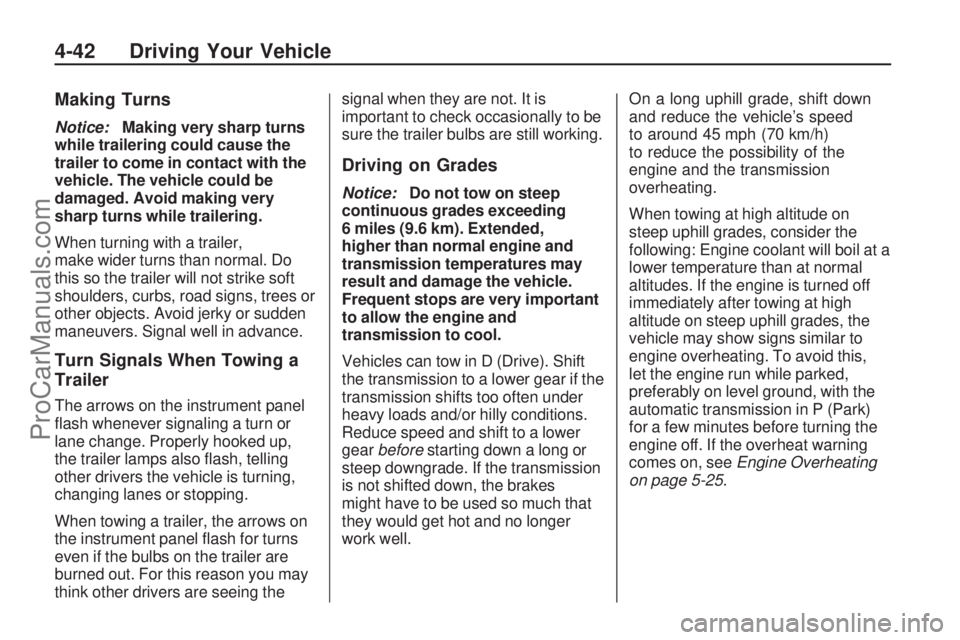
Making Turns
Notice:Making very sharp turns
while trailering could cause the
trailer to come in contact with the
vehicle. The vehicle could be
damaged. Avoid making very
sharp turns while trailering.
When turning with a trailer,
make wider turns than normal. Do
this so the trailer will not strike soft
shoulders, curbs, road signs, trees or
other objects. Avoid jerky or sudden
maneuvers. Signal well in advance.
Turn Signals When Towing a
Trailer
The arrows on the instrument panel
�ash whenever signaling a turn or
lane change. Properly hooked up,
the trailer lamps also �ash, telling
other drivers the vehicle is turning,
changing lanes or stopping.
When towing a trailer, the arrows on
the instrument panel �ash for turns
even if the bulbs on the trailer are
burned out. For this reason you may
think other drivers are seeing thesignal when they are not. It is
important to check occasionally to be
sure the trailer bulbs are still working.
Driving on Grades
Notice:Do not tow on steep
continuous grades exceeding
6 miles (9.6 km). Extended,
higher than normal engine and
transmission temperatures may
result and damage the vehicle.
Frequent stops are very important
to allow the engine and
transmission to cool.
Vehicles can tow in D (Drive). Shift
the transmission to a lower gear if the
transmission shifts too often under
heavy loads and/or hilly conditions.
Reduce speed and shift to a lower
gearbeforestarting down a long or
steep downgrade. If the transmission
is not shifted down, the brakes
might have to be used so much that
they would get hot and no longer
work well.On a long uphill grade, shift down
and reduce the vehicle’s speed
to around 45 mph (70 km/h)
to reduce the possibility of the
engine and the transmission
overheating.
When towing at high altitude on
steep uphill grades, consider the
following: Engine coolant will boil at a
lower temperature than at normal
altitudes. If the engine is turned off
immediately after towing at high
altitude on steep uphill grades, the
vehicle may show signs similar to
engine overheating. To avoid this,
let the engine run while parked,
preferably on level ground, with the
automatic transmission in P (Park)
for a few minutes before turning the
engine off. If the overheat warning
comes on, seeEngine Overheating
on page 5-25.
4-42 Driving Your Vehicle
ProCarManuals.com
Page 261 of 386
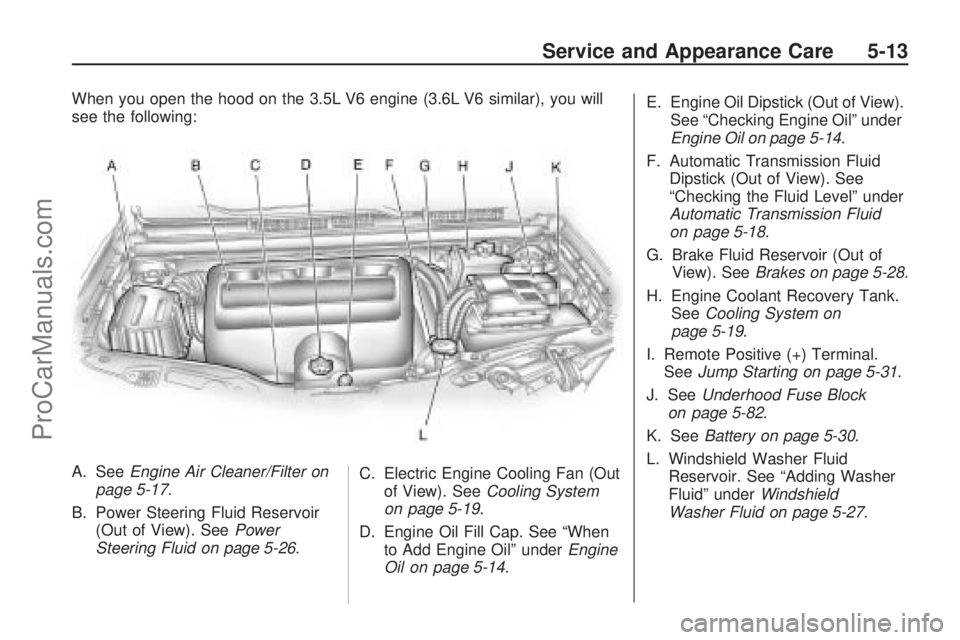
When you open the hood on the 3.5L V6 engine (3.6L V6 similar), you will
see the following:
A. SeeEngine Air Cleaner/Filter on
page 5-17.
B. Power Steering Fluid Reservoir (Out of View). See Power
Steering Fluid on page 5-26 .C. Electric Engine Cooling Fan (Out
of View). See Cooling System
on page 5-19.
D. Engine Oil Fill Cap. See “When to Add Engine Oil” under Engine
Oil on page 5-14. E. Engine Oil Dipstick (Out of View).
See “Checking Engine Oil” under
Engine Oil on page 5-14.
F. Automatic Transmission Fluid Dipstick (Out of View). See
“Checking the Fluid Level” under
Automatic Transmission Fluid
on page 5-18.
G. Brake Fluid Reservoir (Out of View). See Brakes on page 5-28 .
H. Engine Coolant Recovery Tank. See Cooling System on
page 5-19.
I. Remote Positive (+) Terminal. See Jump Starting on page 5-31 .
J. See Underhood Fuse Block
on page 5-82.
K. See Battery on page 5-30 .
L. Windshield Washer Fluid Reservoir. See “Adding Washer
Fluid” under Windshield
Washer Fluid on page 5-27 .
Service and Appearance Care 5-13
ProCarManuals.com
Page 267 of 386

Notice:Use of the incorrect
automatic transmission �uid
may damage the vehicle, and the
damages may not be covered by
the vehicle’s warranty. Always use
the automatic transmission �uid
listed inRecommended Fluids and
Lubricants on page 6-13.
For the 2.4L, 3.5L and 3.6L engines,
the transmission �uid will not
reach the end of the dipstick unless
the transmission is at operating
temperature. If you need to check the
transmission �uid level, please take
your vehicle to your dealer/retailer.Cooling System
When you decide it is safe to lift the
hood, here is what you will see:
A. Electric Engine Fan
B. Coolant Surge Tank
C. Pressure Cap{CAUTION
An electric engine cooling fan
under the hood can start up even
when the engine is not running
and can cause injury. Keep
hands, clothing, and tools away
from any underhood electric fan.
If the coolant inside the coolant
surge tank is boiling, do not do
anything else until it cools down.
The vehicle should be parked on a
level surface.
2.4L L4 Engine shown, 3.5L V6
and 3.6L V6 Engines similar
Service and Appearance Care 5-19
ProCarManuals.com
Page 268 of 386

The coolant level should be between
the MIN and MAX lines. If it is not,
you may have a leak at the radiator
hoses, heater hoses, radiator, water
pump, or somewhere else in the
cooling system.
{CAUTION
Heater and radiator hoses, and
other engine parts, can be very
hot. Do not touch them. If you do,
you can be burned.
Do not run the engine if there is a
leak. If you run the engine, it
could lose all coolant. That could
cause an engine �re, and you
could be burned. Get any leak
�xed before you drive the vehicle.If there seems to be no leak, with
the engine on, check to see if
the electric engine cooling fan is
running. If the engine is overheating,
the fan should be running. If it is
not, your vehicle needs service.
Turn off the engine.
Notice:Engine damage from
running the engine without
coolant is not covered by the
warranty.
Notice:Using coolant other than
DEX-COOL
®can cause premature
engine, heater core, or radiator
corrosion. In addition, the engine
coolant could require changing
sooner, at 30,000 miles
(50 000 km) or 24 months,
whichever occurs �rst. Any
repairs would not be covered by
the vehicle warranty. Always use
DEX-COOL
®(silicate-free) coolant
in the vehicle.
How to Add Coolant to the
Coolant Surge Tank
Notice:This vehicle has a
speci�c coolant �ll procedure.
Failure to follow this procedure
could cause the engine to
overheat and be severely
damaged.
If you have not found a problem
yet, check to see if coolant is
visible in the surge tank. If coolant is
visible but the coolant level is not at
between the MIN and MAX lines, add
a 50/50 mixture of clean, drinkable
water and DEX-COOL
®coolant at
the coolant surge tank, but be sure
the cooling system, including the
coolant surge tank pressure cap, is
cool before you do it. SeeEngine
Coolant on page 5-22for more
information.
5-20 Service and Appearance Care
ProCarManuals.com
Page 270 of 386
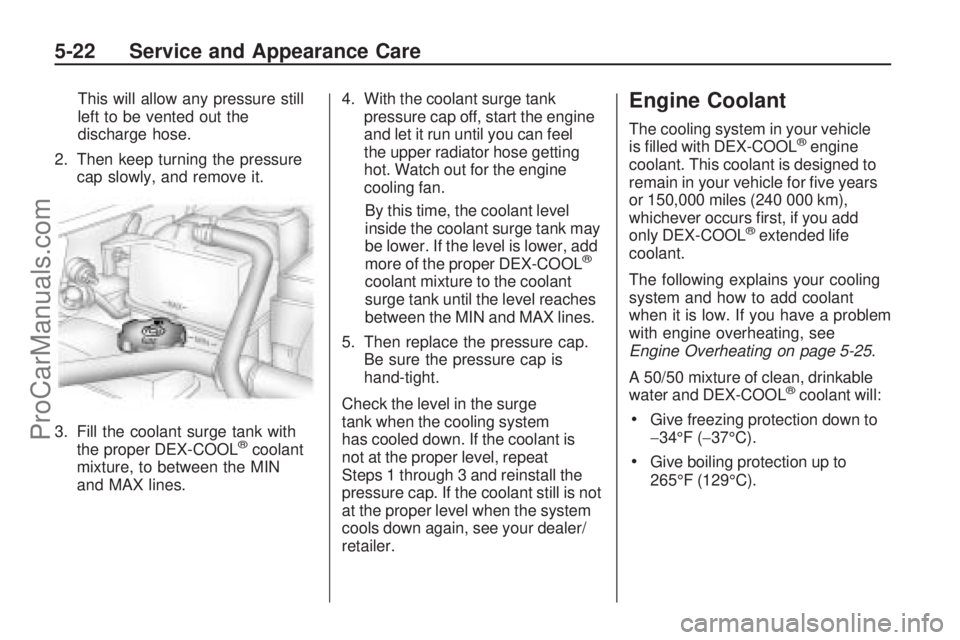
This will allow any pressure still
left to be vented out the
discharge hose.
2. Then keep turning the pressure
cap slowly, and remove it.
3. Fill the coolant surge tank with
the proper DEX-COOL
®coolant
mixture, to between the MIN
and MAX lines.4. With the coolant surge tank
pressure cap off, start the engine
and let it run until you can feel
the upper radiator hose getting
hot. Watch out for the engine
cooling fan.
By this time, the coolant level
inside the coolant surge tank may
be lower. If the level is lower, add
more of the proper DEX-COOL
®
coolant mixture to the coolant
surge tank until the level reaches
between the MIN and MAX lines.
5. Then replace the pressure cap.
Be sure the pressure cap is
hand-tight.
Check the level in the surge
tank when the cooling system
has cooled down. If the coolant is
not at the proper level, repeat
Steps 1 through 3 and reinstall the
pressure cap. If the coolant still is not
at the proper level when the system
cools down again, see your dealer/
retailer.
Engine Coolant
The cooling system in your vehicle
is �lled with DEX-COOL®engine
coolant. This coolant is designed to
remain in your vehicle for �ve years
or 150,000 miles (240 000 km),
whichever occurs �rst, if you add
only DEX-COOL
®extended life
coolant.
The following explains your cooling
system and how to add coolant
when it is low. If you have a problem
with engine overheating, see
Engine Overheating on page 5-25.
A 50/50 mixture of clean, drinkable
water and DEX-COOL
®coolant will:
Give freezing protection down to
−34°F (−37°C).
Give boiling protection up to
265°F (129°C).
5-22 Service and Appearance Care
ProCarManuals.com
Page 272 of 386
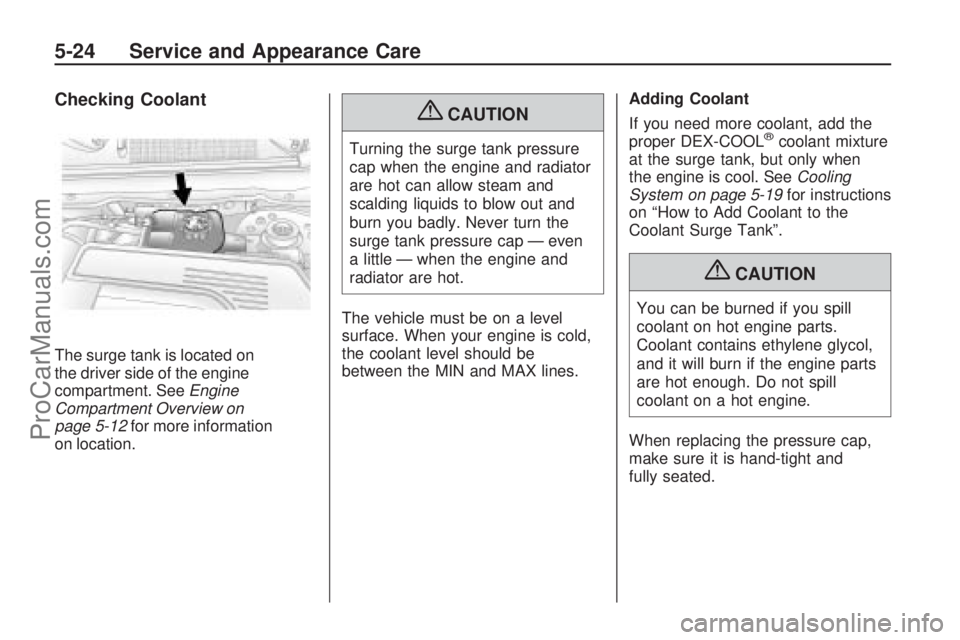
Checking Coolant
The surge tank is located on
the driver side of the engine
compartment. SeeEngine
Compartment Overview on
page 5-12for more information
on location.
{CAUTION
Turning the surge tank pressure
cap when the engine and radiator
are hot can allow steam and
scalding liquids to blow out and
burn you badly. Never turn the
surge tank pressure cap — even
a little — when the engine and
radiator are hot.
The vehicle must be on a level
surface. When your engine is cold,
the coolant level should be
between the MIN and MAX lines.Adding Coolant
If you need more coolant, add the
proper DEX-COOL®coolant mixture
at the surge tank, but only when
the engine is cool. SeeCooling
System on page 5-19for instructions
on “How to Add Coolant to the
Coolant Surge Tank”.
{CAUTION
You can be burned if you spill
coolant on hot engine parts.
Coolant contains ethylene glycol,
and it will burn if the engine parts
are hot enough. Do not spill
coolant on a hot engine.
When replacing the pressure cap,
make sure it is hand-tight and
fully seated.
5-24 Service and Appearance Care
ProCarManuals.com
Page 275 of 386

4. Wipe the cap and the top of the
reservoir clean.
5. Unscrew the cap and wipe the
dipstick with a clean rag.
6. Replace the cap and completely
tighten it.
7. Remove the cap again and look
at the �uid level on the dipstick.
The �uid level should be within the
area indicated on the dipstick
when the engine is cold.
What to Use
To determine what kind of �uid to
use,Recommended Fluids and
Lubricants on page 6-13. Always
use the proper �uid.
Notice:Use of the incorrect �uid
may damage the vehicle and
the damages may not be covered
by the vehicle’s warranty.
Always use the correct �uid
listed inRecommended Fluids
and Lubricants on page 6-13.
Windshield Washer Fluid
What to Use
When you need windshield or rear
window washer �uid, be sure to
read the manufacturer’s instructions
before use. If you will be operating
your vehicle in an area where
the temperature may fall below
freezing, use a �uid that has
sufficient protection against freezing.
Adding Windshield Washer
Fluid
Open the cap with the washer
symbol on it. Add washer �uid until
the tank is full. SeeEngine
Compartment Overview on
page 5-12for reservoir location.Notice:
When using concentrated
washer �uid, follow the
manufacturer’s instructions for
adding water.
Do not mix water with
ready-to-use washer �uid.
Water can cause the solution
to freeze and damage your
washer �uid tank and other
parts of the washer system.
Also, water does not clean as
well as washer �uid.
Fill the washer �uid tank only
three-quarters full when it is
very cold. This allows for �uid
expansion if freezing occurs,
which could damage the tank if
it is completely full.
Do not use engine coolant
(antifreeze) in your windshield
washer. It can damage the
vehicle’s windshield washer
system and paint.
Service and Appearance Care 5-27
ProCarManuals.com
Page 340 of 386
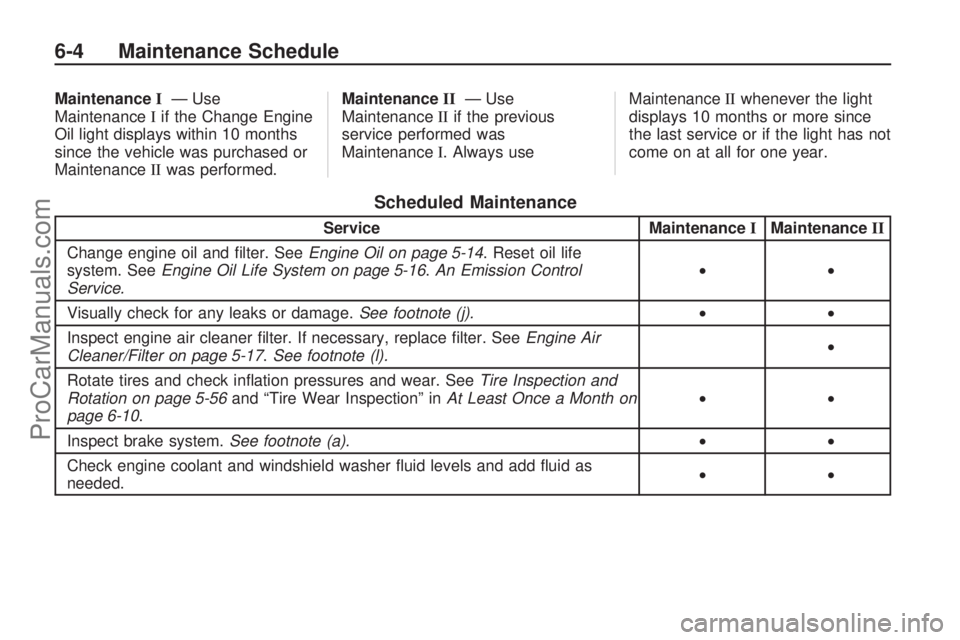
MaintenanceI—Use
Maintenance Iif the Change Engine
Oil light displays within 10 months
since the vehicle was purchased or
Maintenance IIwas performed. Maintenance
II—Use
Maintenance IIif the previous
service performed was
Maintenance I. Always use Maintenance
IIwhenever the light
displays 10 months or more since
the last service or if the light has not
come on at all for one year.
Scheduled Maintenance
Service MaintenanceIMaintenance II
Change engine oil and �lter. See Engine Oil on page 5-14. Reset oil life
system. See Engine Oil Life System on page 5-16 .An Emission Control
Service. ••
Visually check for any leaks or damage. See footnote (j). ••
Inspect engine air cleaner �lter. If necessary, replace �lter. See Engine Air
Cleaner/Filter on page 5-17 .See footnote (l). •
Rotate tires and check in�ation pressures and wear. See Tire Inspection and
Rotation on page 5-56 and “Tire Wear Inspection” in At Least Once a Month on
page 6-10. ••
Inspect brake system. See footnote (a). ••
Check engine coolant and windshield washer �uid levels and add �uid as
needed. ••
6-4 Maintenance Schedule
ProCarManuals.com